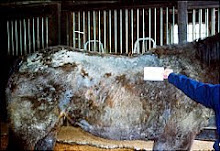On May 2nd, many of the world's fastest thoroughbreds will compete
in the 135th running of the Kentucky Derby. The racetrack success of
these equine stars was once supposed to guarantee them a safe and
long retirement. But according to Melodee Shelley-Bolmgren, founder
of Chez Chevaux, a Washington-based nonprofit thoroughbred rescue
organization, times have never been tougher for these magnificent
creatures.
It's possible — even likely — that one of the horses running in
Saturday's race will end up on a dinner plate somewhere overseas.
This was, in fact, the fate of Ferdinand who won the 1986 Kentucky
Derby and 1987 Breeders' Cup Classic. He was voted the 1987 Eclipse
Award for Horse of the Year, but later proved unsuccessful as a
stallion and his economic value dwindled to the price of the meat on
his bones. In 2002, 16 years after he won the Kentucky Derby,
Ferdinand was shipped off to a slaughterhouse in Japan with little
fanfare. His death served as the catalyst for the Ferdinand Fee, a
donation program to help keep old racehorses alive.
Exceller, the only horse ever to beat two Triple Crown winners,
which he did in the 1978 Jockey Club Gold Cup, died in a Swedish
slaughterhouse in 1997. Phantom on Tour, who ran sixth in the 1997
Kentucky Derby, might have met a similar fate if rescue groups
hadn't intervened before it was too late.
In part due to the poor economy, donations to rescue organizations
are reported to have reached record lows and thoroughbreds, some of
whom have earned hundreds of thousands of dollars for their previous
owners, are being shipped to Canada and Mexico for slaughter.
Without sufficient funds, nonprofits are unable to save these ex-
racers.
"What makes this situation even more tragic is that we see so many
healthy, young thoroughbreds shipped abroad to be slaughtered," says
Shelley-Bolmgren.
To help save the lives of thoroughbreds and retrain them for second
careers as pleasure or show horses, Chez Chevaux has issued a Derby
Day Dollar Challenge. The nonprofit organization hopes to raise
$135,000 in recognition of this year's 135th Derby. Shelley-Bolmgren
says she already has an email box overflowing with requests to help
horses that are in dire need.
According to the Humane Society, the United States sent 98,363
horses to Canada and Mexico for slaughter last year. As of March 28,
2009 17,758 horses had been sent to those two countries for
slaughter. Polls have historically shown that the vast majority of
Americans are against the slaughtering of horses. In Texas (formerly
home to two of this country's equine slaughterhouses), 72 percent of
those polled in 2006 said they were opposed to the slaughtering of
horses for human consumption. That sentiment is shared by most
members of Congress.
But unfortunately the people's voice isn't always heard or honored
in Congress. In September 2006, the United States House of
Representatives approved H.R. 503, the American Horse Slaughter
Prevention Act, which would ban the slaughter of horses in the
United States. However, the bill never made it out of committee in
the Senate. For a multitude of reasons, cattlemen's groups, the
American Quarter Horse Association and the American Association of
Equine Practitioners have gone on the record as "pro-slaughter" and
have found ways to keep this practice alive.
The recent rise in the number of unwanted and neglected horses in
Kentucky has renewed the debate over whether reopening
slaughterhouses in the United States (the last ones closed in 2007)
would help address the problem.
To take the Derby Day Dollar Challenge, please visit Chez Chevaux to
make an online tax-deductible donation. No amount is too small. "If
enough people contributed even a single dollar to horse charities
that would help us save so many animals from certain deaths,"
Shelley-Bolmgren says.
Facts about horse slaughter:
During the last few decades, millions of horses have been
slaughtered in the U.S. and Canada and their meat exported to Europe
and Japan for human consumption.
It is estimated that a third of all slaughter-bound horses in the
U.S. were bred for racing.
Thoroughbreds and other horses are often shipped up to 30 hours
without food or water. When they reach the slaughterhouse, they are
driven into a killing factory and bludgeoned with a four-inch bolt
gun which drives a spike into their skulls. Their throats are then
slit, often while they are still conscious.
Most horses sold at auction are bought by middlemen for slaughter
plants; the horses often go straight to slaughter without disclosure
to the original sellers.
Very little horse meat is used in dog food; some cuts sell for over
$20 per pound for human consumption.
Do you plan to watch the Kentucky Derby this weekend? I encourage
all horse enthusiasts to place your bets on Chez Chevaux or another
horse rescue organization for a guaranteed return on your investment.
Click on title to read more, see video and leave comments;
http://www.sfgate.com/cgi-bin/blogs/pets/detail?entry_id=39238
Friday, May 1, 2009
Subscribe to:
Post Comments (Atom)

















No comments:
Post a Comment